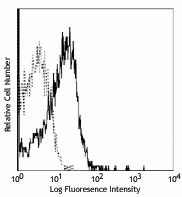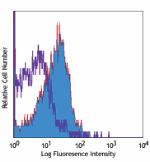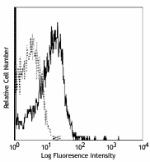- Clone
- 1B1.3a (See other available formats)
- Regulatory Status
- RUO
- Other Names
- IL-10R, Interleukin-10 Receptor
- Isotype
- Rat IgG1, κ

-

C57BL/6 mouse splenocytes stained with 1B1.3a PE
| Cat # | Size | Price | Quantity Check Availability | ||
|---|---|---|---|---|---|
| 112709 | 100 µg | $110.00 | |||
| 112710 | 1 mg | $149.00 | |||
| 112711 | 5 mg | $539.00 | |||
| 112712 | 25 mg | $1408.00 | |||
| 112713 | 50 mg | $2354.00 | |||
| 112714 | 100 mg | $3383.00 | |||
Select size of product is eligible for a 40% discount! Promotion valid until December 31, 2024. Exclusions apply. To view full promotion terms and conditions or to contact your local BioLegend representative to receive a quote, visit our webpage.
CD210 is a 90-110 kD IL-10 receptor. It is a class II cytokine receptor expressed on thymocytes, T cells, B cells, NK cells, monocytes and macrophages. Ligand binding of CD210 induces Jak1 and Tyk, resulting in STAT1 and STAT3 activation. IL-10 receptor stimulation results in the inhibition of cytokine production and the costimulation of B cell proliferation and differentiation. The only known ligand for this receptor is IL-10.
Product Details
- Verified Reactivity
- Mouse
- Antibody Type
- Monoclonal
- Host Species
- Rat
- Immunogen
- Soluble mIL-10R-FLAG-His
- Formulation
- 0.2 µm filtered in phosphate-buffered solution, pH 7.2, containing no preservative.
- Preparation
- The Ultra-LEAF™ (Low Endotoxin, Azide-Free) antibody was purified by affinity chromatography.
- Concentration
- The antibody is bottled at the concentration indicated on the vial, typically between 2 mg/mL and 3 mg/mL. Older lots may have also been bottled at 1 mg/mL. To obtain lot-specific concentration and expiration, please enter the lot number in our Certificate of Analysis online tool.
- Storage & Handling
- The antibody solution should be stored undiluted between 2°C and 8°C. This Ultra-LEAF™ solution contains no preservative; handle under aseptic conditions.
- Application
-
FC - Quality tested
Block - Reported in the literature, not verified in house - Recommended Usage
-
Each lot of this antibody is quality control tested by immunofluorescent staining with flow cytometric analysis. For flow cytometric staining, the suggested use of this reagent is ≤1.0 µg per million cells in 100 µl volume or 100 µl of whole blood. It is recommended that the reagent be titrated for optimal performance for each application.
- Application Notes
-
Additional reported applications (for the relevant formats) include: in vitro and in vivo blocking of ligand binding1-5. For most successful immunofluorescent staining results, it may be important to maximize signal over background by using a relatively bright fluorochrome-antibody conjugate (Cat. No. 112706) or by using a high sensitivity, three-layer staining technique (e.g., including a biotinylated antibody (Cat. No. 112704) or biotinylated anti-rat IgG (Cat. No. 405402) second step, followed by SAv-PE (Cat. No. 405204)). The LEAF™ purified antibody (Endotoxin < 0.1 EU/µg, Azide-Free, 0.2 µm filtered) is recommended for functional assays. For in vivo studies or highly sensitive assays, we recommend Ultra-LEAF™ purified antibody (Cat. No. 112710) with a lower endotoxin limit than standard LEAF™ purified antibodies (Endotoxin < 0.01 EU/µg).
-
Application References
(PubMed link indicates BioLegend citation) -
- O'Farrell A, et al. 1998. EMBO J. 17:1006. (Block)
- Wang W, et al. 2004. FASEB J. 18:1043. (Block)
- Vieira PL, et al. 2004. J. Immunol. 172:5986. (Block)
- Iwashiro M, et al. 2001. P. Natl. Acad. Sci. USA 98:9226. (Block)
- Vicari AP, et al. 2002. J. Exp. Med. 196:541. (Block)
- Product Citations
-
- RRID
-
AB_11147950 (BioLegend Cat. No. 112709)
AB_11147950 (BioLegend Cat. No. 112710)
AB_11147950 (BioLegend Cat. No. 112711)
AB_11147950 (BioLegend Cat. No. 112712)
AB_11147950 (BioLegend Cat. No. 112713)
AB_11147950 (BioLegend Cat. No. 112714)
Antigen Details
- Structure
- Class II cytokine receptor family, 90-110 kD
- Distribution
-
Thymocytes, T and B cells, NK cells, monocytes, macrophages
- Function
- Inhibits cytokine production, costimulates B cell proliferation and differentiation
- Ligand/Receptor
- IL-10
- Cell Type
- B cells, Macrophages, Monocytes, NK cells, T cells, Thymocytes
- Biology Area
- Immunology
- Molecular Family
- CD Molecules, Cytokine/Chemokine Receptors
- Antigen References
-
1. Ho A, et al. 1993. P. Natl. Acad. Sci. USA 90:11267.
2. Tan JC, et al. 1993. J. Biol. Chem. 268:21053.
3. Niemand C, et al. 2003. J. Immunol. 170:3263.
4. Corinti S, et al. 2001. J. Immunol. 166:4312. - Gene ID
- 16154 View all products for this Gene ID
- UniProt
- View information about CD210 on UniProt.org
Other Formats
View All CD210 Reagents Request Custom Conjugation| Description | Clone | Applications |
|---|---|---|
| Biotin anti-mouse CD210 (IL-10 R) | 1B1.3a | FC |
| PE anti-mouse CD210 (IL-10 R) | 1B1.3a | FC |
| Purified anti-mouse CD210 (IL-10 R) | 1B1.3a | FC,Block |
| Ultra-LEAF™ Purified anti-mouse CD210 (IL-10 R) | 1B1.3a | FC,Block |
| TotalSeq™-B1032 anti-mouse CD210 (IL-10 R) | 1B1.3a | PG |
| TotalSeq™-C1032 anti-mouse CD210 (IL-10 R) | 1B1.3a | PG |
Compare Data Across All Formats
This data display is provided for general comparisons between formats.
Your actual data may vary due to variations in samples, target cells, instruments and their settings, staining conditions, and other factors.
If you need assistance with selecting the best format contact our expert technical support team.
-
Biotin anti-mouse CD210 (IL-10 R)

C57BL/6 mouse splenocytes stained with biotinylated 1B1.3a, ... -
PE anti-mouse CD210 (IL-10 R)

C57BL/6 mouse splenocytes stained with 1B1.3a PE -
Purified anti-mouse CD210 (IL-10 R)

C57BL/6 mouse splenocytes stained with 1B1.3a PE -
Ultra-LEAF™ Purified anti-mouse CD210 (IL-10 R)

C57BL/6 mouse splenocytes stained with 1B1.3a PE -
TotalSeq™-B1032 anti-mouse CD210 (IL-10 R)
-
TotalSeq™-C1032 anti-mouse CD210 (IL-10 R)
